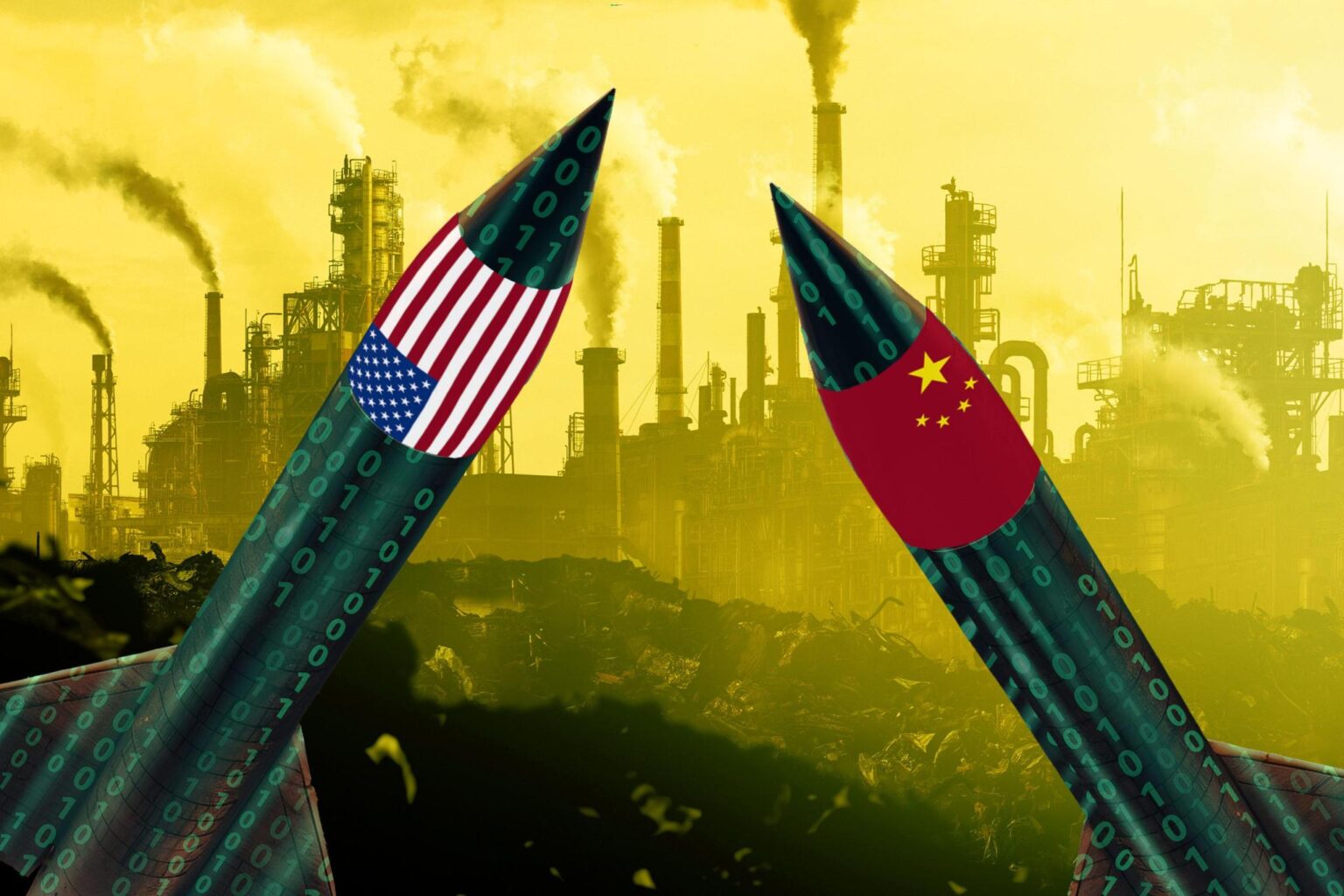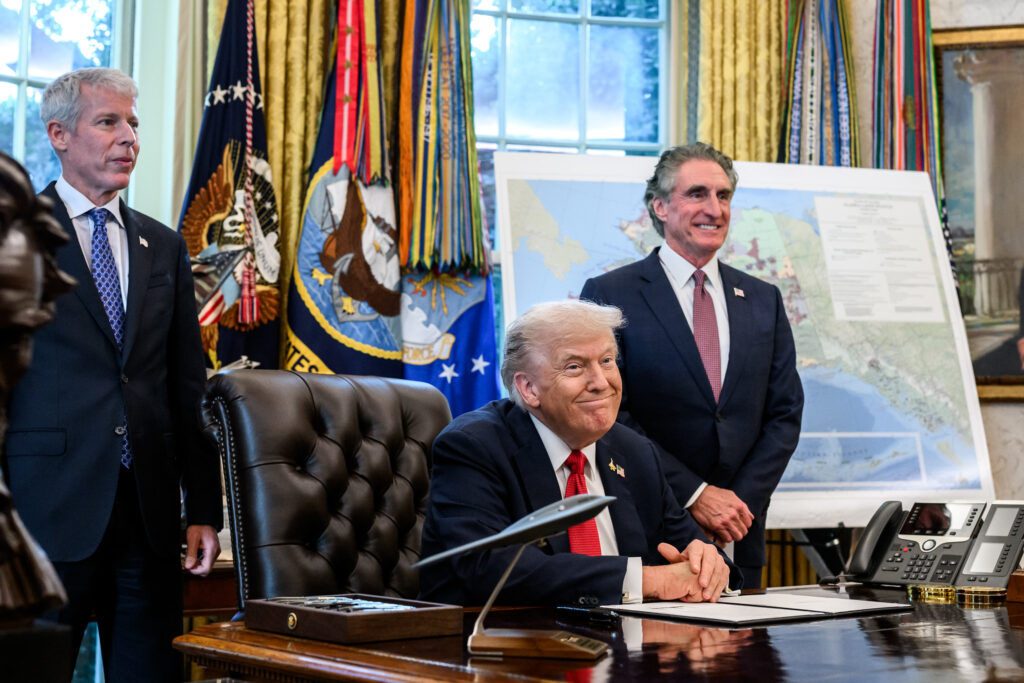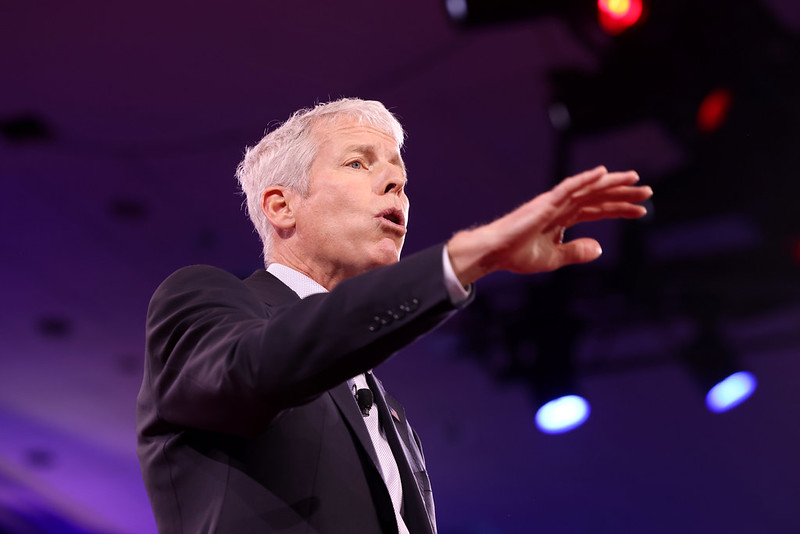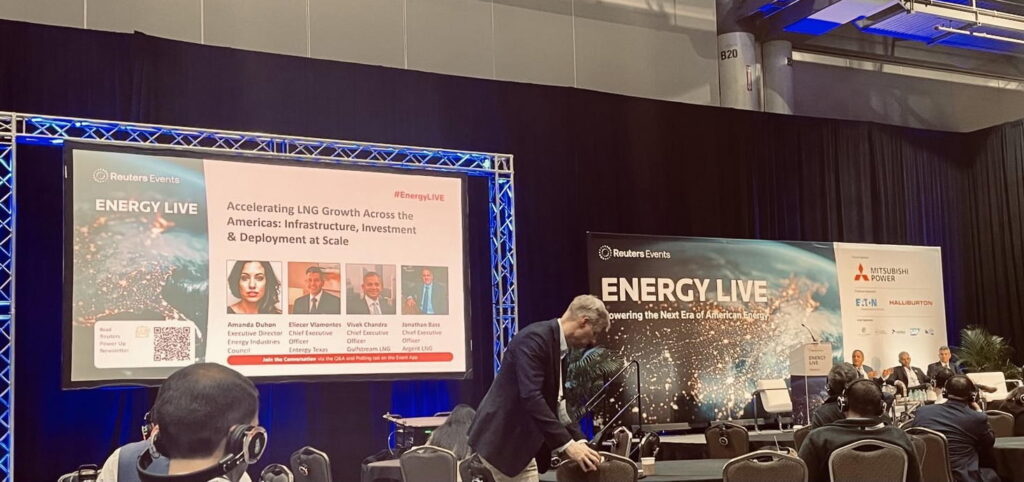As the U.S. braces for a surge in artificial intelligence (AI)–related electricity demand, the natural gas industry has a message for the public: Fossil fuels must power the future’s data centers, the computer-filled warehouses where AI models like ChatGPT primarily train and deploy.
A range of oil and gas industry groups and industry-friendly nonprofits are making the case that AI’s growing hunger for power requires a robust fossil-energy scale-up, DeSmog has found. This massive deployment of dirty power is a national security necessity, they say. And Trump administration officials have embraced this message. But experts on renewable energy economics and deployment say this narrative is misleading. They posit that a new era of gas-powered data centers is neither necessary nor inevitable.
“The idea that AI simply requires natural gas and nothing else, that renewables cannot be used, is absolutely false,” said Safak Yucel, a sustainable business operations expert at Georgetown University. “That’s not true, and that’s essentially fake news.”
Yet on September 10, at the Gastech industry conference in Milan, U.S. Interior Secretary Doug Burgum took the stage with U.S. Energy Secretary Chris Wright. “The real existential threat right now is not one degree of climate change,” Burgum said. “It’s the fact that we could lose the AI arms race if we don’t have enough power.” The only way to win that race, he said, is with “affordable, reliable energy,” industry’s shorthand for fossil fuels.
Wright, a former gas industry executive, argued that the coming ramp-up should be met primarily with gas, coal, and oil, which he called the three fastest-growing energy sources. “All of them are growing faster than wind and solar combined,” he said.
Solar is the fastest growing source of electricity in the U.S. and globally, followed by wind. Together, after a years of record-breaking growth, these sources provided 15 percent of all electricity generated globally in 2024. And both solar and wind now generate power more cheaply than fossil fuel plants do, even without subsidies. But that hasn’t stopped a growing chorus of the fossil fuel industry, its industry-funded allies, Trump administration officials, and the chief executive himself from telling a very different story.
The White House did not provide comment on DeSmog’s findings by press time.
Can Fossil Fuels or Renewables Grow Fast Enough for AI Demand?
In March 2024, the Texas Public Policy Foundation (TPPF), a think tank closely linked to fracking billionaire and Trump megadonor Tim Dunn, announced a new initiative: The National Center for Energy Analytics (NCEA). It said NCEA would “restore balance and inject more realism into national energy policy debates.” Launched in part by a $250,000 donation from a family foundation linked to a prominent oil and gas exploration firm, NCEA is today helmed by Mark P. Mills.
With numerous industry ties and a history of downplaying the climate crisis, Mills and NCEA almost immediately began hyping the need for a massive surge in energy production to meet the demands of AI, while attacking renewables as unfit for the job.
“There aren’t many ways to meet the velocity and scale of electric demand coming without a boom in building more natural-gas-fired power plants,” he wrote in City Journal, an outlet run by the Koch-funded Manhattan Institute. TPPF helped amplify Mills’ claims, with a top official writing in July 2024 that “AI’s insatiable appetite for energy can’t be satisfied by renewables.”
Mills’ preferred term for this outlook: “energy realism,” a worldview that suggests the U.S. must forgo climate goals if the nation is serious about AI.
By this spring, Mills was repeating his claims in testimony before Congress, arguing that only fossil fuels will allow America to beat China in a quest for AI dominance. “Reality, and arithmetic, show that the needed power won’t come from squeezing more out of existing assets, or stopping coal plant retirements, or utility-scale wind and solar, nor from building new nuclear plants,” he said. “All that will help, but it won’t be enough, soon enough. Most of the new power will come from natural gas combustion turbines and engines. Those can and are being built rapidly.”
Subscribe to our newsletter
Stay up to date with DeSmog news and alerts
The Heartland Institute is pushing a similar message. That climate crisis–denying think tank has received millions in funding from the Mercer family and Donors Trust dark, and historically been funded by Big Tobacco, the Koch family and ExxonMobil. “AI will be incompatible with anti-fossil energy activism,” Heartland editorial director Chris Talgo claimed in a June 2024 op-ed in The Hill, citing China and other “adversarial nations” racing for “AI supremacy.”
The narrative that only fossil fuels can power AI’s projected ramp-up is “100 percent wrong,” said Dennis Wamsted, an energy analyst at the Institute for Energy Economics and Financial Analysis (IEEFA). He pointed to the fact that renewables have jumped to nearly 40 percent of Texas’ energy supply, up from just10 percent a decade ago.
“Texas is also the grid that’s growing fastest in the United States,” he said. The fact that renewables’ slice is growing fastest at a time the whole pie is growing “is proof positive to me that it’s possible essentially anywhere,” Wamsted said.
Huge numbers of renewable projects are waiting to come online. 95 percent of the projects requesting permission to join the larger energy grid are renewable, said Caitlin Marquis, managing director at Advanced Energy United, a trade association representing the renewables industry. By contrast, additional growth from natural gas could be hamstrung by massive bottlenecks in supply chain and highly skilled labor related to the large turbines needed to power data centers. The three producers that make up 90 percent of that market have already sold out all their inventory through 2030, according to Wamsted.
“They can’t just go expand,” he said.
Spurred partly by the AI boom, Texas companies proposed building more than 100 natural gas plants in the coming years, and the state created a $7.2 billion fund to grease the wheel. But so far only two have been approved for about $300 million in loans, Canary Media reports. Meanwhile developers have canceledseven others, invoking rising costs and long turbine wait times.
In response to DeSmog’s questions, NCEA spokesperson Aaron Mays wrote that Mark Mills has “frequently challenged the assumptions used to propose energy policies of all kinds, including those anchored in climate-centric objectives.” Mays also said that “whether renewables can meet AI’s energy needs is an active debate in both the business and academic worlds,” while largely pointing to the work of NCEA’s own scholars to suggest renewable energy is more expensive and slower growing than fossil fuels.
The “often poor accuracy, or incompleteness, of energy facts in media and policy discussions is the issue that animated the creation of the NCEA,” Mays wrote.
How Reliable Is Renewable Energy?
This year, the Consumer Energy Alliance, another industry-funded nonprofit advocacy group, launched a campaign attacking renewables’ reliability and credibility. In a wide range of blog posts, op-eds, and media appearances, CEA staff argue that scaling up energy availability for data centers is of paramount importance— and that only fossil fuels are stable enough to fit the bill.
“America cannot win the AI race without abundant, affordable, reliable energy. Full stop,” CEA president David Holt wrote in a RealClearEnergy op-ed in May. “National security depend[s] on getting this right.”
In a July op-ed for the same outlet, he specifically blamed the phase-out of fossil fuel plants for a supposed U.S. energy shortfall, arguing that renewables are simply too undependable to provide data center electricity: “We’re shutting down power plants that work 24/7 and replacing them with sources that work when the weather cooperates.”
Georgetown’s Yucel said that narrative is highly misleading. Co-located solar and wind energy tend to complement one another well. Sunlight is available during the day and wind tends to pick up at night — generating more than enough electricity to provide steady power in many U.S. regions. When solar and wind are feeding into a regional grid, their output tends to be “relatively stable,” regardless of time of day, he said.
Meanwhile, advanced batteries give renewables backup storage capacity regardless of time of day — an approach that’s still cost-competitive with natural gas, according to Advanced Energy United managing director Harry Godfrey.
CEA is a project of HBW Resources, an energy-focused PR company founded by longtime Republican lobbyist Michael Whatley. In addition to a working on behalf of oil and gas clients, it has advocated for the Keystone XL Pipeline and the Canadian tar sands industry. Some CEA member companies also focus on renewable energy, and the group tends to advocate for an all-of-the-above energy approach.
But despite paying lip service to keeping “every option on the table,” Holt and his colleagues routinely contend that renewables are a far more dubious power source. In a 2024 op-ed titled “The Blackouts Are Coming! The Blackouts Are Coming!,” Holt warned the public not to “forget the real world realities and cost implications of attempting to outlaw oil and natural gas now and rely on wind and solar.”
“Mandating politically-preferred energy forms that can’t yet, if ever, replace abundant natural gas, oil, and nuclear will bring energy shortages, electricity blackouts, and higher prices at home and at the pump,.” he wrote.
Yet, during the 2021 power grid failure in Texas, renewables produced more reliably than fossil-derived energy sources, including gas, according to a federal study. When Texas faced record-setting energy demand during last summer’s most sweltering days, solar kept the lights on and air conditioners running, according to the National Renewable Energy Lab. The idea that renewables will bring higher prices to consumers is simply false, Yucel said.
“I’m essentially a business school professor. So I am unapologetically capitalist,” he said. “From the profitability perspective, the winner is absolutely clear: renewables.”
CEA did not respond to a request for comment.
Industry Would Like a Word
Oil and gas companies haven’t just relied on advocacy groups to spread their message on AI. Increasingly, they’ve started making the case themselves.
In recent months, Chevron CEO Mike Wirth has made “energy realism” arguments in media appearance for outlets like CNBC and Fox News. “U.S. policy has often prioritized climate idealism over energy pragmatism,” he wrote in a recent Fox News op-ed. “Wind, solar, and battery technologies will play a key role in our energy future, but they are not available at the scale or reliability needed to fuel expected AI center demand. And these combined sources are more expensive than U.S. natural gas.”
“It’s not a given that we will win this race,” Wirth told The New York Post this month. “We need to match up this great innovation with our great energy resources.”
Oil and gas trade groups are promoting the same theme in a steady drumbeat of op-eds, blog posts, and paid social media advertisements. “Of all the available energy sources in the U.S., natural gas is uniquely positioned to support the rapid demand growth required for America to lead the way in AI without jeopardizing reliability or affordability,” Karen Harbert, president of the American Gas Association (AGA), wrote in a July op-ed for RealClearEnergy, an argument she tied to winning a race “against competitors like China.” The American Petroleum Institute (API) echoed these claims in blog posts andpublic comments by its CEO Mike Sommers.
RealClear Media, RealClearEnergy’s parent company, itself has extensive ties to right-wing disinformation networks. In 2021, it announced an initiative to collaborate with the State Policy Network, a network of free market think tanks, to promote op-eds from its members, which in the past have included both Texas Public Policy Foundation and Consumer Energy Alliance.
Chevron, AGA, and API did not respond to requests for comment.
Washington Steps in
On July 23, at a Washington, D.C. gathering of tech leaders convened by the nonprofit Hill and Valley Forum, President Trump performatively signed a trio of executive orders intended to jump start America’s artificial intelligence capacity. On stage next to him, a big blue sign made the day’s theme unmistakable: “Winning the AI Race.”
The overarching “AI Action Plan”released that day vowed to reject “climate dogma and bureaucratic red tape.” Its language suggested that government support for renewables stands at odds with America’s growing appetite for energy , echoing the narrative promoted for months by NCEA, CEA, and other groups. It also referred to a need to grow only “reliable, dispatchable energy” — industry code for fossil fuels.
One of the executive orders made clear that the federal government would only help expedite projects relying on “natural gas turbines, coal power equipment, nuclear power equipment, geothermal power equipment, and any other dispatchable baseload energy sources,” while excluding wind and solar.
For its part, the tech industry played along.
“America’s unique advantage that no country could possibly have is President Trump,” said Nvidia CEO Jensen Huang, in a public discussion at the summit. “On the first day of his administration, he realized the importance of AI and he realized the importance of energy. For the last, I don’t know how many years, energy production was vilified.”
Huang, whose company dominates production of computer chips for data centers, seemed to equate“energy” with fossil fuels, and “vilification” with decarbonization. Nvidia did not respond to a request for comment by press time.
Meanwhile, Trump has been more than willing to vilify certain energy sources, making no bones about his antipathy for wind and solar. “We don’t allow windmills, and we don’t want the solar panels,” he said, during an August 26 cabinet meeting. “For firing up your big plants, it doesn’t work. It’s very unstable.”
At a Council on Foreign Relations summit this month, Energy Secretary Wright said the Federal Energy Regulatory Commission wanted to prioritize “plants that produce electricity 24/7, whether the wind is blowing or the sun is shining,” saying that was necessary “to stay ahead of China in AI.”
Wright then compared allowing China to get ahead in AI to letting Germany build the first atomic bomb during World War II. “AI is going to have massive national defense and national security ramifications,” he said. If China got meaningfully ahead of us in AI, we become the secondary nation of the planet, that’s a different world we don’t want to go to.”
Since January, the Trump administration has blocked or delayed at least six major wind projects, including a $6.2 billion project off Maryland’s coast that was 80 percent complete. Just this month, it moved to halt a 141-turbine project off the coast of Massachusetts. If ramping up energy supply were a truly critical national security concern, experts say this would be the last thing you’d want to do.
“There clearly is a disconnect between parts of the administration,” Wamsted said. “Because if you need all that power as fast as you can get it, we should finish all those offshore wind facilities.”
If America’s government doesn’t understand this, rest assured that China’s does. Between January and May 2025, China installed a record-breaking amount of solar and wind — enough to power the entire nation of Turkey.
Subscribe to our newsletter
Stay up to date with DeSmog news and alerts






